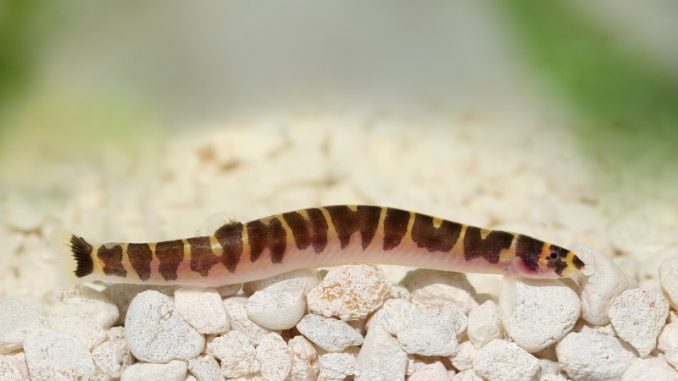
Loaches are freshwater tropical fish native to the waters of Asia. With elongated bodies and colorful features, loaches are popular aquarium fish and are widely for sale amongst aquatic dealers.
There are more than 200 species of loaches. These colorful fish belong to the Actinopterygii class and stem from the superfamily Cobitoidea.
Loaches are bottom dwellers in their natural environment and in-home aquariums, and the fish spend most of their time scavenging for morsels of food and rotting plant material.
These fish are commonly sold as denizens, or popular occupants of tropical fish tanks. Some loaches are diurnal, meaning they are more active during the day, while other loaches are nocturnal.
TABLE OF CONTENTS
Clown Loach
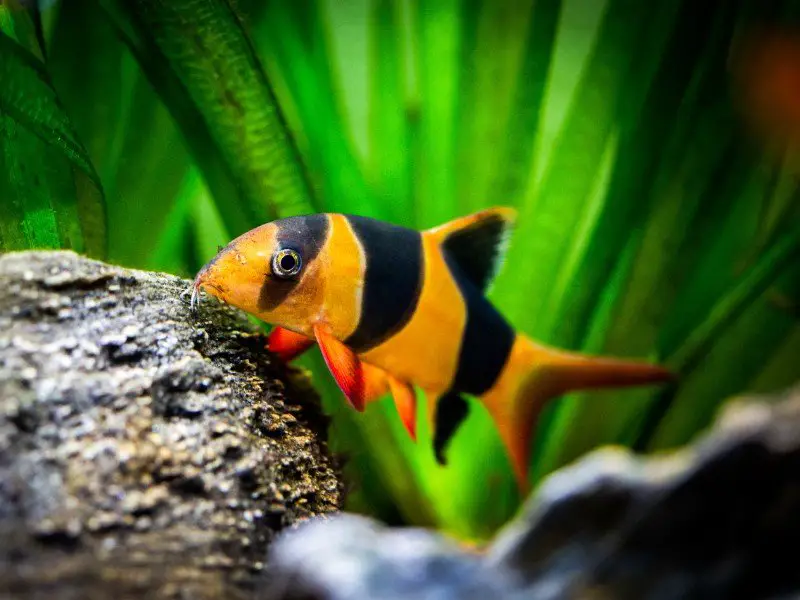
| Care level: | Temperament: | Color: | Lifespan: | Size: |
| Easy–Moderate | Peaceful | White, red, orange, and black | 10 years | 6–12 inches |
| Water temperature: | Water pH: | Tank size: | Diet: | Scientific name: |
| 75–81°F | 6.0–6.5 | 50 gallons or more | Omnivore | Chromobotia macracanthus |
The clown loach is a popular freshwater fish that originates from the waters of Borneo. Clown loaches are omnivores that eat snails, vegetables, leaf litter, and fish eggs.
The clown loach has a bright, elongated body with bands of white and orange or white and red. Three dominant black bands start at the dorsal fin and stretch to the clown loach’s belly, with the third band covering the eyes like a mask.
The clown loach’s body is arched toward the dorsal fin and flattened to the ventral side. The clown loach has large fleshy lips edged with four sets of barbels.
Feeding and Habitat
Clown loaches are docile fish that school in groups of four to five. Clown loaches prefer acidic water. While the fish like clear water, they also thrive in a black water environment. Clown loaches make good tank mates for neon tetras.
Behavior
Clown loaches are playful fish, providing hours of amusement to the avid fishkeeper.
Kuhli Loach
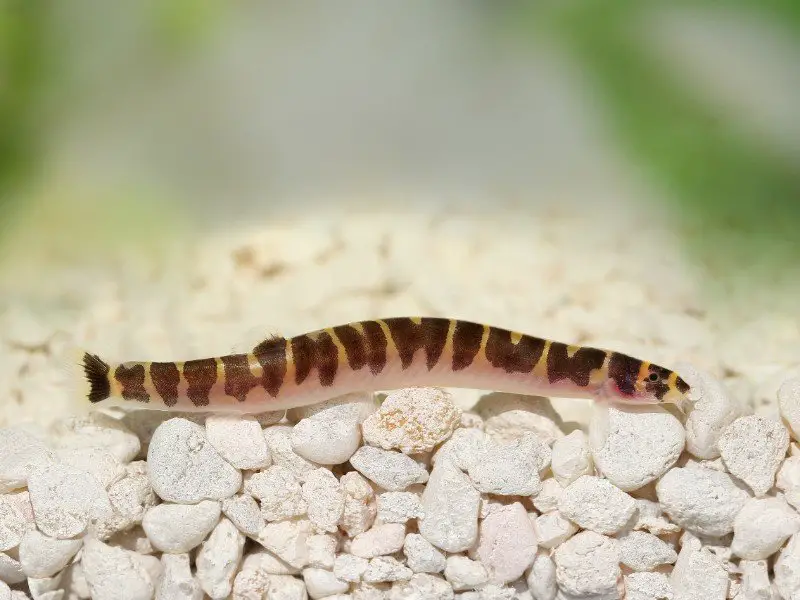
| Care level: | Temperament: | Color: | Lifespan: | Size: |
| Moderate–Advanced | Peaceful | Black, pink, and yellow | 10 years | 4 inches |
| Water temperature: | Water pH: | Tank size: | Diet: | Scientific name: |
| 75–85 °F | 6.0–7.0 | 5–15 gallons | Omnivore | Pangio kuhlii |
Kuhli loaches are hardy, bottom-dwelling loaches of the Pangio genus. The fish’s colorful bodies are yellowy-pink and eel shaped, with ten to 15 blackish brown stripes.
The native waters of the kuhli loach are in Indonesia and Malaysia.
Feeding and Habitat
Kuhli loaches prefer small schools of three to four loaches, and the fish are nocturnal. Feed kuhli loaches at dusk. Kuhli loaches feed on whatever they can find, including algae, making the fish popular tank cleaners.
Behavior
Best for advanced aquarium keepers, kuhli loaches easily catch diseases and are delicate to medicate.
Hillstream Loach
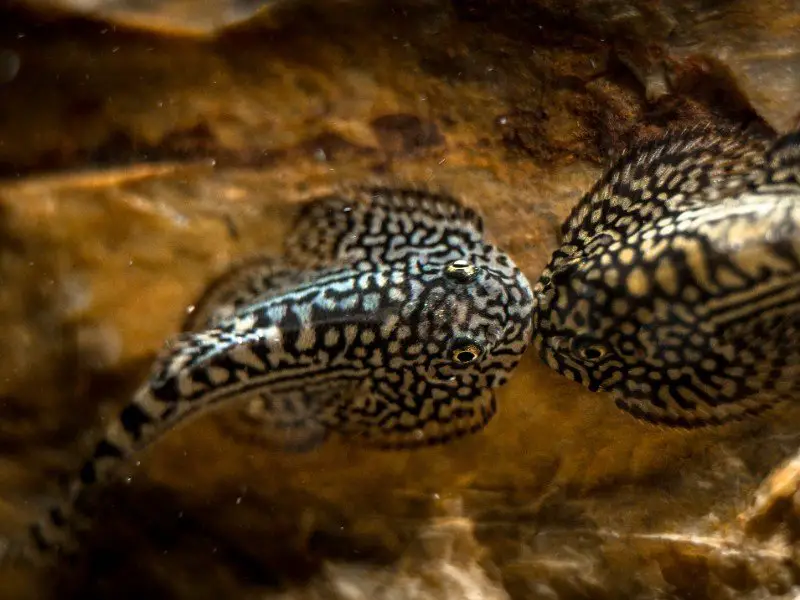
| Care level: | Temperament: | Color: | Lifespan: | Size: |
| Moderate | Peaceful | Yellow/light green and dark brown | 8–10 years | 3 inches |
| Water temperature: | Water pH: | Tank size: | Diet: | Scientific name: |
| 68–75 °F | 6.0–8.0 | 3–10 gallons | Omnivore | Sewellia lineolata |
Originating in hillside streams of Vietnam, the hillstream loach is shaped more like a stingray than other loaches.
With a dark brown body spotted with yellow or greenish dots, the hillstream loach has a translucent underside with visible internal organs. Powerful fins and a two-part sucker mouthpiece allow the hillstream loach to cling to rocks in fast-flowing rivers where this omnivore feeds on algae and plant material.
Hillstream loaches are active in the day, and swim along the rocky bottom of tropical aquariums. Although hillstream loaches are fairly hardy, the fish require knowledgeable fishkeeping.
Feeding and Habitat
Hillstream loaches prefer fast-flowing, oxygen-rich water with a slightly acidic pH. Feed your hillside loaches shrimp, algae, and algae wafers. Fish flakes that sink to the bottom are also a good choice, but there are several other fish foods to choose from.
Group hillstream loaches in threes because these fish prefer to move in trios.
Behavior
Hillstream loaches are shy loaches, and when disturbed, the fish swim away. Watching these loaches latch to the side of your glass tank is entertaining.
Yoyo Loach
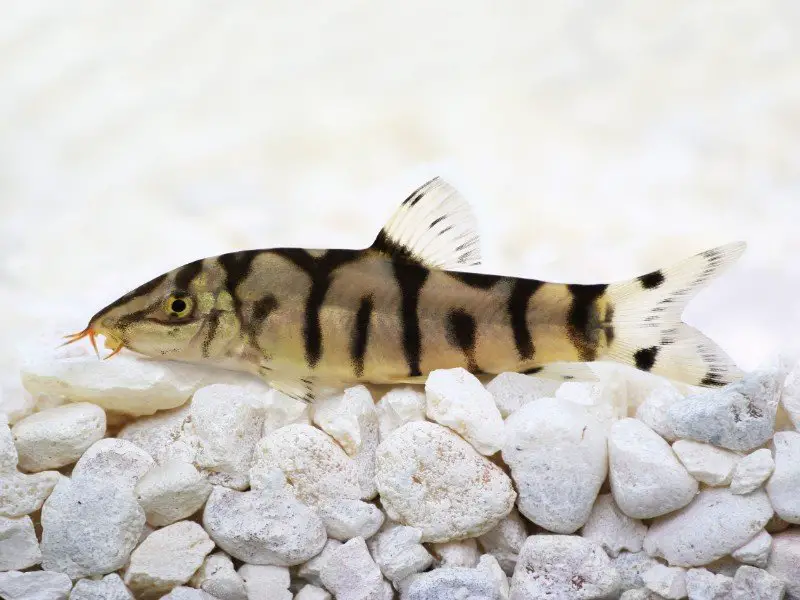
| Care level: | Temperament: | Color: | Lifespan: | Size: |
| Moderate | Active, friendly | Silver and dark brown | 6–16 years | 3–6 inches |
| Water temperature: | Water pH: | Tank size: | Diet: | Scientific name: |
| 73–82 °F | 6.0–7.6 | 3–12 gallons | Omnivore | Botia almorhae |
The yoyo loach is a friendly, active fish with a long thin body, silver coloring, and dark brown patches that join to spell the letters “y” and “o” on the fish’s sides. Adult yoyo loaches have a more net-like pattern. The head of an adult loach points downward with wide jaws that are edged with four sets of barbels.
Feeding and Habitat
The yoyo loach is native to Bangladesh and Nepal and can also be found in India. Yoyo loaches enjoy slow moving currents, and in nature, and are found in river bends and rocky ponds. The yoyo loach spawns upriver. The fish feed on snails and shrimps as well as fish flakes and plant material.
Behavior
When adult yoyo loaches feed near the surface, they suck in air, producing a clicking sound. Keep yoyo loaches in schools of six to eight.
Zebra Loach
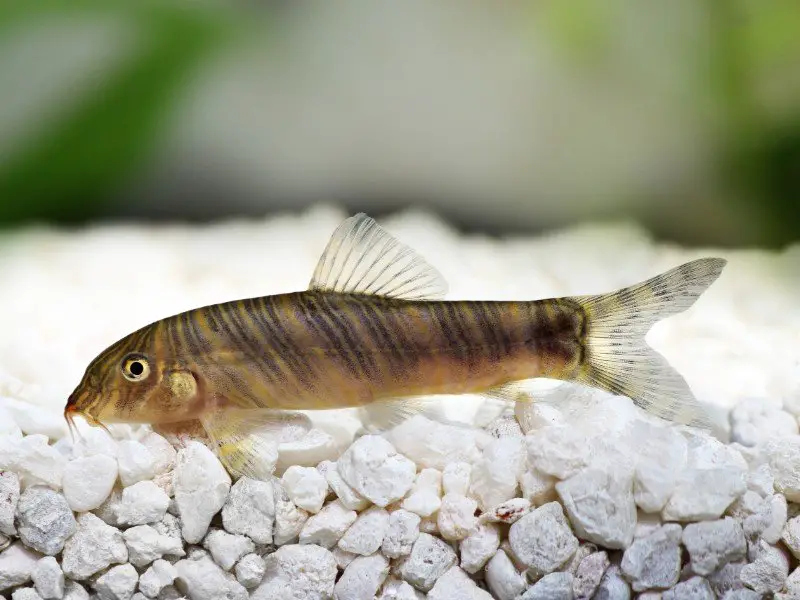
| Care level: | Temperament: | Color: | Lifespan: | Size: |
| Moderate | Peaceful | Orange and brown bands | 10 years | 4 inches |
| Water temperature: | Water pH: | Tank size: | Diet: | Scientific name: |
| 73–79°F | 6.0–6.5 | 20 gallons | Omnivore | Botia striata |
The zebra loach is a small to medium fish with an elongated body, flattened laterally with vertical stripes on the body and fins. The zebra loach is a friendly, community fish.
Feeding and Habitat
Zebra loaches feed on bloodworms, mosquito larvae, and daphnia in the wild. In your aquarium, you can feed zebra loaches sinking catfish pellets and fish flakes. Found in the rivers of the Western Ghats of India, the zebra loach prefers slow-moving water.
Behavior
Zebra loaches are nocturnal bottom dwellers and scavenge the substrate for algae, shrimp, eggs, and protein foods.
Weather Loach
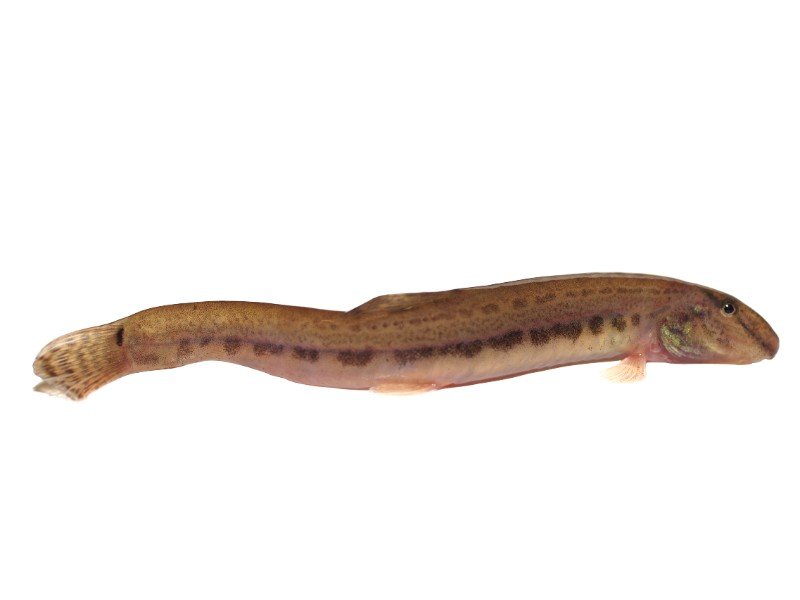
| Care level: | Temperament: | Color: | Lifespan: | Size: |
| Easy | Peaceful | Golden bronze with brown spots forming bands | 7–10 years | 6–12 inches |
| Water temperature: | Water pH: | Tank size: | Diet: | Scientific name: |
| 64–75 °F | 6.0–8.0 | 55 gallons | Omnivore | Misgurnus anguillicaudatus |
The weather loach, or dojo loach, is native to Siberia, Japan, Korea, China, and northern Vietnam. Weather loaches have elongated, eel-like bodies and are golden bronze in color with a scattering of brown spots. These spots merge into three or more bands that run the length of the fish’s bodies.
Weather loaches have downturned mouths with five sets of barbels the fish use to excavate the substrate.
Feeding and Habitat
Weather loaches are bottom feeders and bury themselves in the substrate, searching for shrimp, snails, and fallen fish pellets. In the wild, weather loaches dig through the silt in rivers, searching for food.
Behavior
The weather loach is a fast-moving fish known to predict weather changes because of its sensitivity to barometric changes. Before stormy weather, the weather loach becomes more active than usual, and may even swim vertically.
Weather loaches dig up plant roots, so deep-rooted plants are needed in the tank.
Horsehead Loach
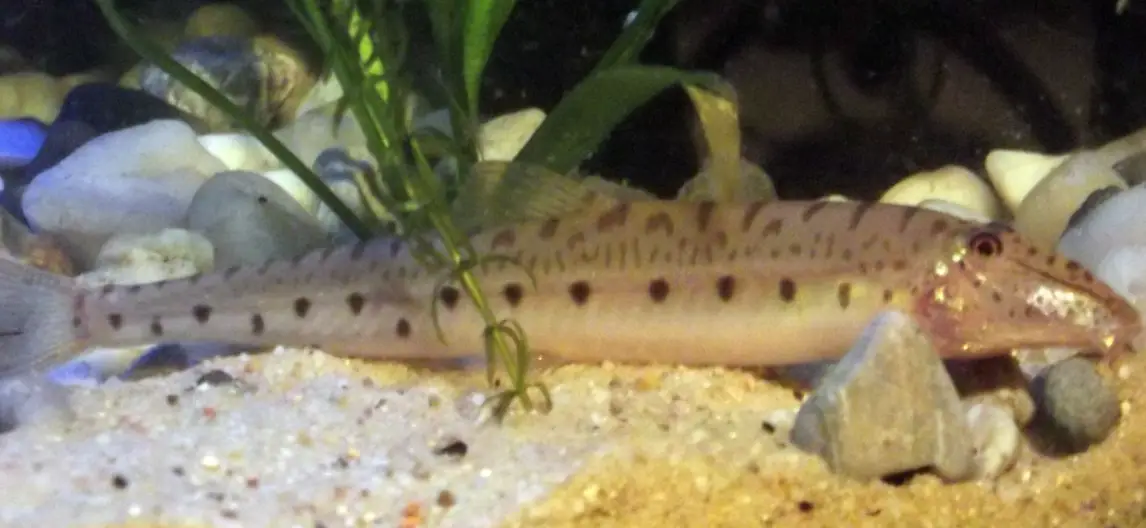
| Care level: | Temperament: | Color: | Lifespan: | Size: |
| Moderate | Peaceful | Light bronze with brown dots | 7–10 years | 12 inches |
| Water temperature: | Water pH: | Tank size: | Diet: | Scientific name: |
| 79–84°F | 6.0–6.5 | 20 gallons | Omnivore | Acantopsis dialuzona |
The horsehead loach has an elongated body with a head that resembles a horse head. With the horsehead loach’s bronze color and brown dots, this loach blends in with the bottom silt. The horsehead loach often buries itself in the sand at the bottom of the aquarium.
The natural habitat of the horsehead loach is southeast Asia. The fish frequents river beds and feasts on crustaceans and plant matter.
Feeding and Habitat
In aquariums, the horsehead loach feeds on fish flakes, sinking pellets, frozen foods, vegetables, and algae wafers.
Clean water is essential for a horsehead loach as the fish has small scales and a scaleless head that is susceptible to disease like bacterial infections. Ensure your aquarium has aqua silt and pebble substrate and prevent strong currents that stress these fish.
Characteristic Behavior
The horsehead loach is peaceful and prefers to sleep during the day, emerging at night to scavenge for food. Keep one horsehead loach per tank, or if the tank is large enough and you have sufficient caves and underwater plants, keep two fish for mating purposes.
Lepto Loach
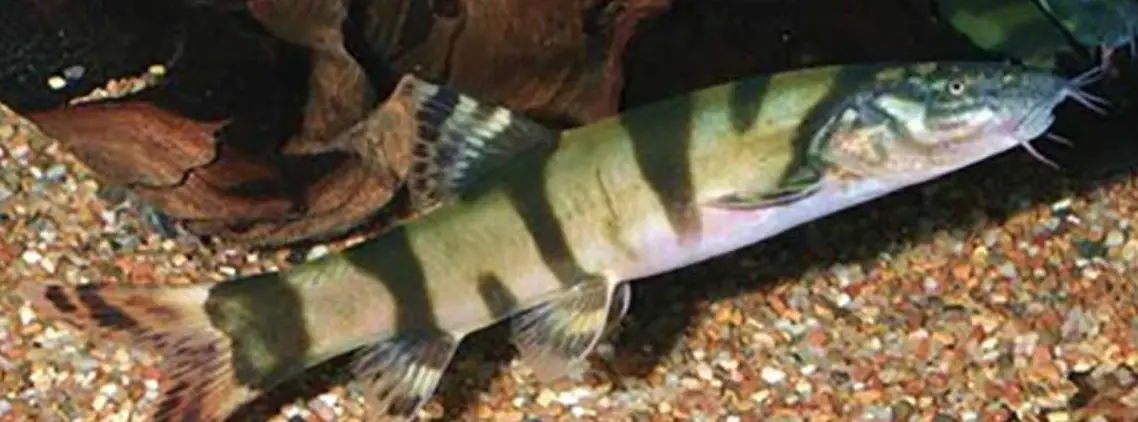
| Care level: | Temperament: | Color: | Lifespan: | Size: |
| Moderate | Aggressive | Golden brown, dark brown | 5–8 years | 12 inches |
| Water temperature: | Water pH: | Tank size: | Diet: | Scientific name: |
| 72–77 °F | 6.0–7.5 | 20 gallons | Omnivore | Leptobotia guilinensis |
Lepto loaches are golden brown with dark brown bands across their bodies, banded fins, and a banded tail. Originating from China, the lepto loach frequents river beds with silt and stone substrates.
Feeding and Habitat
The lepto loach is not a common fish store find. Aquariums need to offer clear, well-oxygenated water and a substrate of aqua soil and stone. This provides an ideal environment for lepto loaches to hunt crustaceans and insects like bloodworms and larvae, which the fish enjoy doing in the wild.
Behavior
Lepto loaches are some of the most aggressive loach species. While the lepto loach tolerates most fish, this loach is known for fin nibbling and territorial disputes, and is even known to hunt and eat small fish. Because lepto loaches are more active than other loaches, the fish can be observed interacting with other fish. Keep lepto loaches in groups of four or more fish.
Dwarf Chain Loach
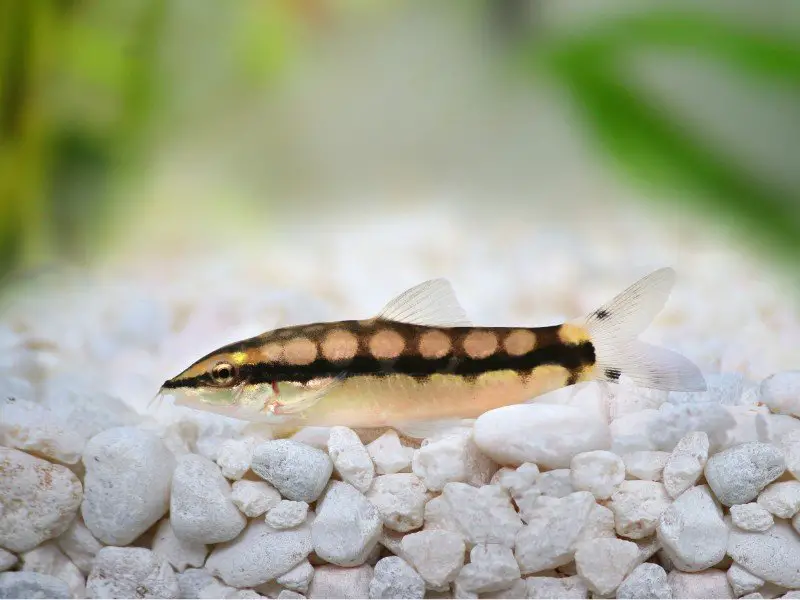
| Care level: | Temperament: | Color: | Lifespan: | Size: |
| Moderate | Active, semi-aggressive | Golden brown, dark brown | 8–12 years | 2 inches |
| Water temperature: | Water pH: | Tank size: | Diet: | Scientific name: |
| 68–86 °F | 6.0–7.5 | 30 gallons | Omnivore | Ambastaia sidthimunki |
The dwarf chain loach is indigenous to Thailand, and in the wild, the fish is a nationally protected species. With a thick, cylindrical body, the chain loach has all the classic loach features, including the downturned mouth. The chain loach has four sets of thick but short barbels that it uses to forage for food in the silt.
The dwarf chain loach has a base color of gold or silver on its bottom half, while its top half has a lace-like black overlay. Gold or silver patches shine through the black coloring as a pattern of dots.
Feeding and Habitat
Because the dwarf chain loach is so active, with a semi-aggressive temperament, it’s best to keep the fish in a large tank, with lots of space to move. Make sure there are hiding spots in the tank for the loaches to hide.
Create a moderate current for these fish, and populate the tank with water plants like Java moss to ensure a steady supply of fresh greens for the chain loaches to nibble on. Feed your dwarf chain loaches shrimp in brine, snails, bloodworms, and fish pellets.
Characteristic Behavior
Dwarf chain loaches are considered a feisty species, and when the fish are kept in a tank with other fish, fighting may occur. Keeping larger groups will limit aggression, and schools of six to ten fish are recommended.
Choosing & Caring for Different Loach Types
In an aquarium, loaches are bottom-dwelling fish that love to school in groups of four to eight, where the fish add color and pattern to the overall aquarium appearance.
Loaches aren’t the easiest of all aquarium fish to care for, and parasites and bacterial infections are common in loaches. Experienced fish keepers will have no issues administering medicines to delicate loaches like the horsehead loach, but beginners should choose hardier loach, such as the weather loach.
Be sure there are enough hiding spaces in your tank, and your loaches will happily tolerate busier fish species while the loaches scavenge for food.
Be careful when housing loaches together. A more aggressive loach species, such as the lepto loach, may attack and eat a smaller and more docile loach such as the kuhli loach.

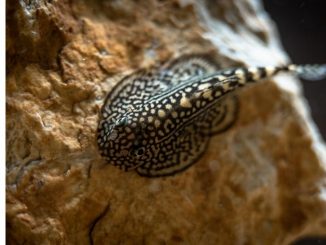
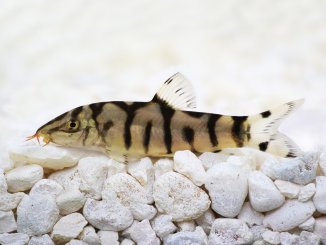
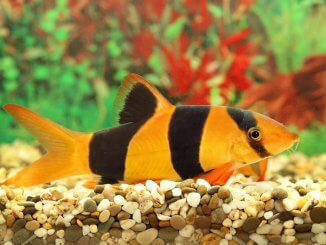
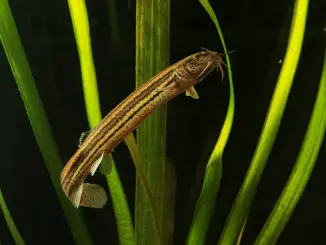
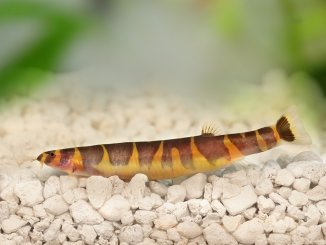
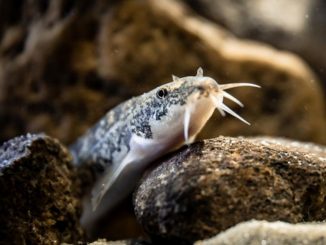
Be the first to comment